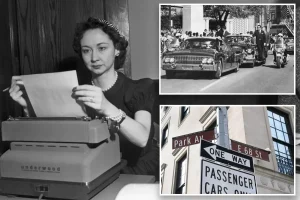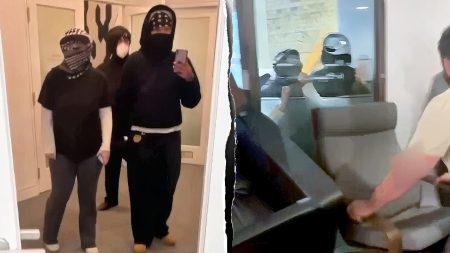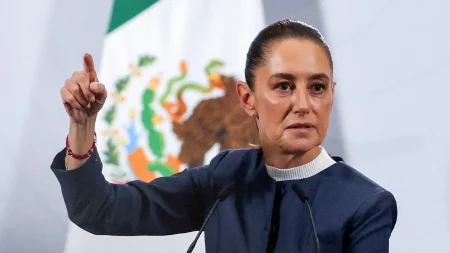Memorial Mural for Hamas Victims Destroyed in Milan
In a heartbreaking act of vandalism, a memorial mural in Milan, Italy honoring Shiri Bibas and her two young sons—Ariel, 4, and Kfir, 10 months—was completely destroyed this week. The artwork, created by contemporary artist AleXsandro Palombo, had already been defaced once before, but this time the damage was far more extensive. The Star of David was completely removed from the mural, and Shiri’s face was damaged beyond recognition. “Those who committed this vile act are cowards who despise the West and our values of freedom,” Palombo told Fox News Digital, expressing his dismay at what he views as an attempt to erase history and deny the existence of an entire people. The destruction comes at a time when antisemitic incidents are on the rise globally, making this act of vandalism all the more disturbing for its apparent targeted nature.
The original mural was positioned outside the Qatari consulate in Milan as a poignant memorial to the Bibas family, who were victims of the October 7, 2023 Hamas attacks in Israel. Last month, during a memorial service, vandals had already begun defacing the artwork by covering Shiri’s face with an appropriated image from Vancouver street artist iHeart. The image depicted a crying boy upset about lack of social media attention, which the vandal modified by adding “No War” text and a red bull’s-eye over Shiri’s face. Palombo unequivocally labeled this initial act as antisemitic, explaining that “Striking the Israeli flag that shielded the children is a way of saying that no place is safe for Jews, not even in the heart of Europe.” The symbolism of this defacement was clear to the artist—it represented an attack not just on his artwork, but on Jewish identity itself.
The latest vandalism went much further, completely obliterating key elements of the memorial. Palombo discovered the extent of the damage through messages from concerned followers on his social media accounts. The children’s images were damaged alongside their mother’s, and the Star of David—a central symbol of Jewish identity in the mural—was completely removed. “Removing the Star of David and obscuring Shiri’s face means attempting to erase history, to deny the existence of a people, to impose an ideology that rejects democratic coexistence and attempts to rewrite the present with the ink of fear,” Palombo explained. This systematic destruction of Jewish symbols and identities within the artwork reflects a disturbing pattern of antisemitism that has been increasing in Europe and around the world since the conflict in Gaza began.
For Palombo, the Israeli flag in his original mural was more than just a national symbol—it represented protection and belonging. “The flag, in the mural, was not just a cloak that protected the children; it was also the sign of their belonging, the symbol of an identity that embraces them and, at the same time, exposes them,” he said. The artist emphasized how this symbol embodied both the tenderness of a people protecting their children and the vulnerability of those who become targets precisely because of their identity. The destruction of these elements in the mural carries profound symbolic weight, representing an attack on the very idea of Jewish safety and belonging in European society. It remains unclear whether the mural will be restored or recreated, leaving a void where once stood a memorial to innocent victims.
Unfortunately, this is not the first time Palombo’s work has been targeted. His murals dedicated to Holocaust survivors—including Auschwitz survivor Sami Modiano, Italian survivor Liliana Segre, and Hungarian-born survivor Edith Bruck—have previously been vandalized. These repeated attacks on artworks commemorating Jewish suffering reveal a pattern that extends beyond random vandalism to targeted antisemitism. Despite these challenges, Palombo remains resolute in his artistic mission, stating: “I will respond as I always have, by continuing with my art without taking a single step back, because every attempt at erasure will be an opportunity to reaffirm who we are.” His determination speaks to the importance of maintaining visible memorials to victims of terrorism and genocide, even in the face of those who would prefer such histories be erased.
In a time of rising antisemitism and increasing polarization around the Israeli-Palestinian conflict, Palombo’s stance represents a commitment to using art as a form of resistance against hatred. “Free, present, and determined not to retreat even a millimeter before this tsunami of fanaticism, fundamentalism and mad radicalism,” he declared, articulating his unwavering dedication to his artistic practice despite the threats and destruction his work faces. The vandalism of the Bibas family memorial serves as a sobering reminder of how artistic expressions of grief and commemoration can become battlegrounds in larger cultural and political conflicts. As communities around the world struggle with how to address the complex emotions surrounding the ongoing Middle East conflict, this incident highlights how easily memorials to innocent victims can be caught in the crossfire of ideological disputes, and how crucial it is to protect the dignity of all victims regardless of one’s political stance.















